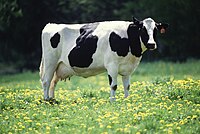
Photo from wikipedia
The real time knowledge of dairy milk composition can be used as a tool to guarantee milk quality and safety, offering additional information for dairy producers and consumers. To carry… Click to show full abstract
The real time knowledge of dairy milk composition can be used as a tool to guarantee milk quality and safety, offering additional information for dairy producers and consumers. To carry out these in situ analyses, methodologies based on Near Infrared (NIR) portable sensors have a great potential as an advisory tool. The main goals of the present work have been to develop a methodology using a hand-held portable NIR spectrophotometer to collect raw milk spectra, including the development of calibration models for the analysis of protein, fat and solids-non-fat (SNF) of raw milk and further to transfer the developed models to another portable unit. A total of 542 fresh milk samples were scanned over the NIR spectral range (1600–2400 nm) using a hand-held MicroPhazir™ (MP) NIR spectrometer and different instrumental configurations. The best results for repeatability and reproducibility calculated as root mean squared (RMS) were obtained using a 17 mm cuvette thickness. The displayed predictive ability of calibration models measured as Standard error of prediction/Standard error of cross validation were 0.96; 0.72 and 0.83 for fat, protein and SNF contents, respectively. For cloning purposes an additional MP unit (satellite) has been used. A standardization set of 10 samples enabled standardization of both instruments. After applying standardization matrix, Standard error of differences between master and satellite reached great reduction, 68% for fat, 66% for protein and 54% for SNF. Moreover, the demonstrated ability of sharing calibration models among several units is essential for implementation of portable instruments for in-situ analysis to provide indicators of milk composition at farm level.
Journal Title: Food Control
Year Published: 2017
Link to full text (if available)
Share on Social Media: Sign Up to like & get
recommendations!